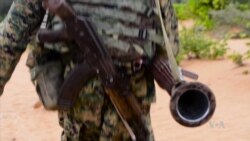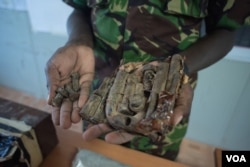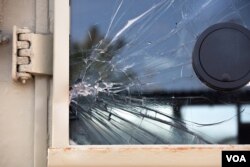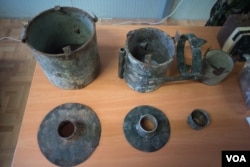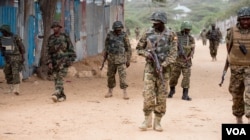A platoon of African Union soldiers patrol a village outside Mogadishu.
They walk on foot ahead of three armored vehicles in order to sweep for improvised explosive devices (IEDs) planted by al-Shabab insurgents.
The goal is to find and defuse any bombs before they go off.
Over the last five years, the African Union (AU) troops, called AMISOM, forced al-Shabab from most major towns, but the rebels have regrouped with IEDs as their weapon of choice.
The insurgents have developed a sophisticated IED building network, regularly targeting both soldiers and civilians in ever larger attacks which have managed to slow AMISOM's advance.
The IEDs have been very effective
"IEDs are the biggest threat in this counter-insurgency, counter-terrorism operation," says AMISOM Deputy Force Commander Major General Nakibus Lakara. "Al-Shabab has been able to leverage its expertise on IEDs to very, very devastating effect."
2016 is set to be the worst year yet for IED attacks in Somalia, with more than 225 attacks so far, according to the Sahan Research Group.
In late August, blasts at two hotels in Mogadishu killed 22 people. Shortly after, a car bomb killed a senior Somali general and his bodyguards.
Though there are no exact numbers, hundreds are believed to have been killed form IED attacks in the last 12 months.
The bombs are getting bigger too, up to 80 kilograms compared to five or 10 kilograms just a few years ago, according to Major General Lakara.
IEDs come in different forms
"The use of IEDs has really evolved. IEDs are in different types. Trucks that are filled with explosives. There are pressure plate IEDs. There are also magnetic IEDs. IEDs that are remote controlled, as a combination of this really creates a lot of challenge," the general explained.
One of al-Shabab's most devastating tactics are "complex attacks" which begin with a large IED blast followed by gunmen who spray bullets at survivors and responders.
But IEDs are also effective because they are so simple.
No need to import IED parts
Most of the materials to build an IED are available in Somalia, including cell phones to trigger explosives made from fertilizer or old munitions.
IEDs are often filled with ball bearings and nails to maximize carnage.
The only imported components are blast caps and detonators believed to be smuggled from Yemen, according to AMISOM commanders and independent researchers.
"The IEDs they manufacture gives them a lot of flexibility," says AMISOM IED expert Hollypass Lagat. "They can place on a road, on the side of a road, under vehicles. They are easily modified. They can easily be transported. They are easily connected, and the triggerman can easily hide somewhere."
This flexibility makes it difficult for AMISOM to counter the IED threat.
Counter measures
AMISOM and Somali security forces have modified their patrols with IEDs in mind. They also search cars in places like Mogadishu where attacks are most frequent.
But better intelligence is needed to break up the bomb-making groups.
"Keeping an eye on where potential IED factories might be, keeping an eye on where the materials are coming from, if certain materials, which are known IED components, are visible in high quantities or running through the hands of certain people, now that kind of intelligence can start to dismantle an IED network," says Andres Perez, a counterterrorism expert at the Royal United Services Institute for Defense and Security Studies.
For AMISOM soldiers on the frontlines, reducing the IED threat can not come soon enough.




